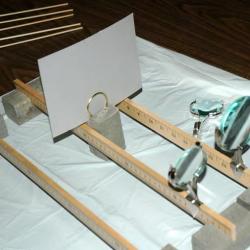Source Institutions
Source Institutions
Add to list Go to activity
Activity link broken? See if it's at the internet archive

This hands-on astronomy activity allows you to create a “cutaway” telescope to clearly show how reflector and refractor telescopes work. Learners will understand more about how telescopes work, the differences between telescopes made with mirrors and those made with lenses, and how we are continuing the tradition of Galileo and Newton in building new telescopes today. The 48-page PDF contains step-by-step instructions, photos and illustrations, presentation tips, background information, and ready-to-print handouts.
- 10 to 30 minutes
- 10 to 30 minutes
- Over $20 per group of students
- Ages 8 - adult
- Activity, Demonstration, Model
- English
Quick Guide
Materials List (per group of students)
- foam strip
- skewer sticks
- glue
- concave mirror—75 mm diameter x 150mm FL
- lens: dbl convex 50mm diam x 200mm FL
- lens: dbl convex 50mm diam x 75mm FL
- lens: dbl convex 75mm diam x 200mm FL
- lens paper pack of 50 sheets
- 2-lens holder—75mm lens
- 2-lens holder—38mm lens (for 50mm lenses)
- 3—meter-stick sections
- optic bench object marker
- screen support
- key ring for screen holder
- optical bench supports
- 1" round glass mirror
- binder clip
- 2 - screens - laminated vellum
- 5 – Tyvek® envelopes
- labels (small) for each lens and mirror to put on the Tyvek® envelopes
- black plastic sheeting square
- crescent moon shape
- wax paper square
- flashlight & batteries
- rubber band—to attach moon cutout to flashlight
- scissors
- tape
- pencil
- business card, book, magazine, or other paper with small writing on it.
- box or books to raise flashlight to appropriate height.
- table(s)
- backup batteries for lantern flashlight (optional)
- stainless steel spoon (for “Further Exploration” )
- 8" paper plate (for “Further Exploration”)
- drawing of an eye (for “Further Exploration”)
- small flashlight (for “Further Exploration”)
Subjects
-
Earth and Space Science
-
Astronomy
- Stars and Galaxies
-
Astronomy
-
Physical Sciences
-
Light and Optics
- Lenses and Mirrors
- Reflection and Refraction
-
Light and Optics
-
Life Sciences
-
Human Senses and Perception
- Vision
-
Human Senses and Perception
-
The Nature of Technology
-
Technology and Society
- Technology and History
-
Technology and Society
Audience
To use this activity, learners need to:
- see
- touch
Learning styles supported:
- Involves hands-on or lab activities
Other
Components that are part of this resource:
This resource is part of:
Access Rights:
- Free access
By:
Rights:
- All rights reserved, Astronomical Society of the Pacific, 2009
Funding Source:
- National Science Foundation, 0813414
